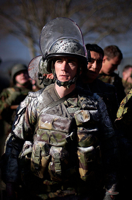Can “cliodynamics” help historians predict future unrest? [Social Science]
[Via io9]
Unlike physicists and chemists, historians have been unable to formulate grand equations or immutable laws. The trends of history, it would seem, are outside the scope of reproducible science.
But a new discipline called “cliodynamics” is looking to change all that. After studying and mapping key indicators of history, University of Connecticut’s Peter Turchin believes that he’s detected consistent cycles in human history — cycles that he argues could actually help us predict the future.
Turchin, a professor of population dynamics, named the new discipline after Clio, the ancient Greek muse of history. He, along with other colleagues, are working to apply scientific methods to history by analyzing broad social forces that impact and shape all human societies.
Writing in Nature, Laura Spinney describes how Turchin’s analysis relies on four main variables: population numbers, social structure, state strength, and political instability. She elaborates:[
More]
While I’d like to know more about the metrics here –how are violent episodes tracked, for example, it fits in quite well with one of my favorite books, The Fourth Turning. That book delineated a four generation cycle of 80-100 years that was needed to fully work our societal problems.
But it had as one of its principles that there were conflicts at each half generation. These conflicts often served to make the final conflict inevitable.
According to the Fourth Turning, written in the late 90s, we are in the middle of the final conflict for the latest cycle, the one that started after WW2 and saw its Second Turning conflict in the 60s.
We are seeing a large number of new conflicts today that are replaying the fights of the 60s – abortion, contraception, etc. I hope we make it through sometime in the next decade. That is about what these cycles would predict.
 by
by 